Retail moves fast. Your systems should too.
But if you’re stuck with siloed data, slow processes, or IT bottlenecks, you already know the cost: slow decisions, missed opportunities, and teams constantly playing catch-up.
That’s where Microsoft Power Platform steps in.
From building custom apps with Power Apps, to automating routine tasks with Power Automate, making faster decisions with Power BI, and improving service with Copilot Studio—you don’t need months. You don’t need a dev team.
You just need the right low-code tools, and a partner like us, who knows how to make them work for retail.
Retail leaders like IKEA, Walgreens, and Macy’s are already using it to drive efficiency and stay agile. If you’re looking to simplify operations, move faster, and make smarter decisions— Power Platform for retail is built for exactly that.
In this blog post, we’ll explore how it’s solving real-world retail problems with field-proven use cases, challenges, and their solutions, so you can drive faster checkouts. smarter inventory, and easier reporting without breaking budgets or overwhelming your IT team.
Why Retail Needs Power Platform Now?
Retail has changed more in the last five years than in the two decades before. Customers want more, they expect speed, ease, and personalization across every channel. Yet, many retailers still rely on siloed systems, manual tasks, and outdated tools that slow decisions and overwork teams.
Power Platform for retail helps fix that. It brings your data together, cuts down repetitive work, and gives your team the power to build apps, automate workflows, and analyze insights, without waiting on IT or adding more to your tech stack.
Whether it’s automating stock checks across stores, tracking real-time customer behavior, or building a custom returns app, Power Platform enables faster, low-code innovation that keeps you agile and cost-efficient.
Overcoming Retail Challenges with Power Platform Capabilities
Retail teams face common daily hurdles—slow processes, disconnected systems, and too much dependency on IT. It holds back innovation. And it makes simple tasks harder than they should be. Microsoft Power Platform helps solve these issues without adding complexity. It helps remove them quickly and without heavy IT lift. Here’s how:
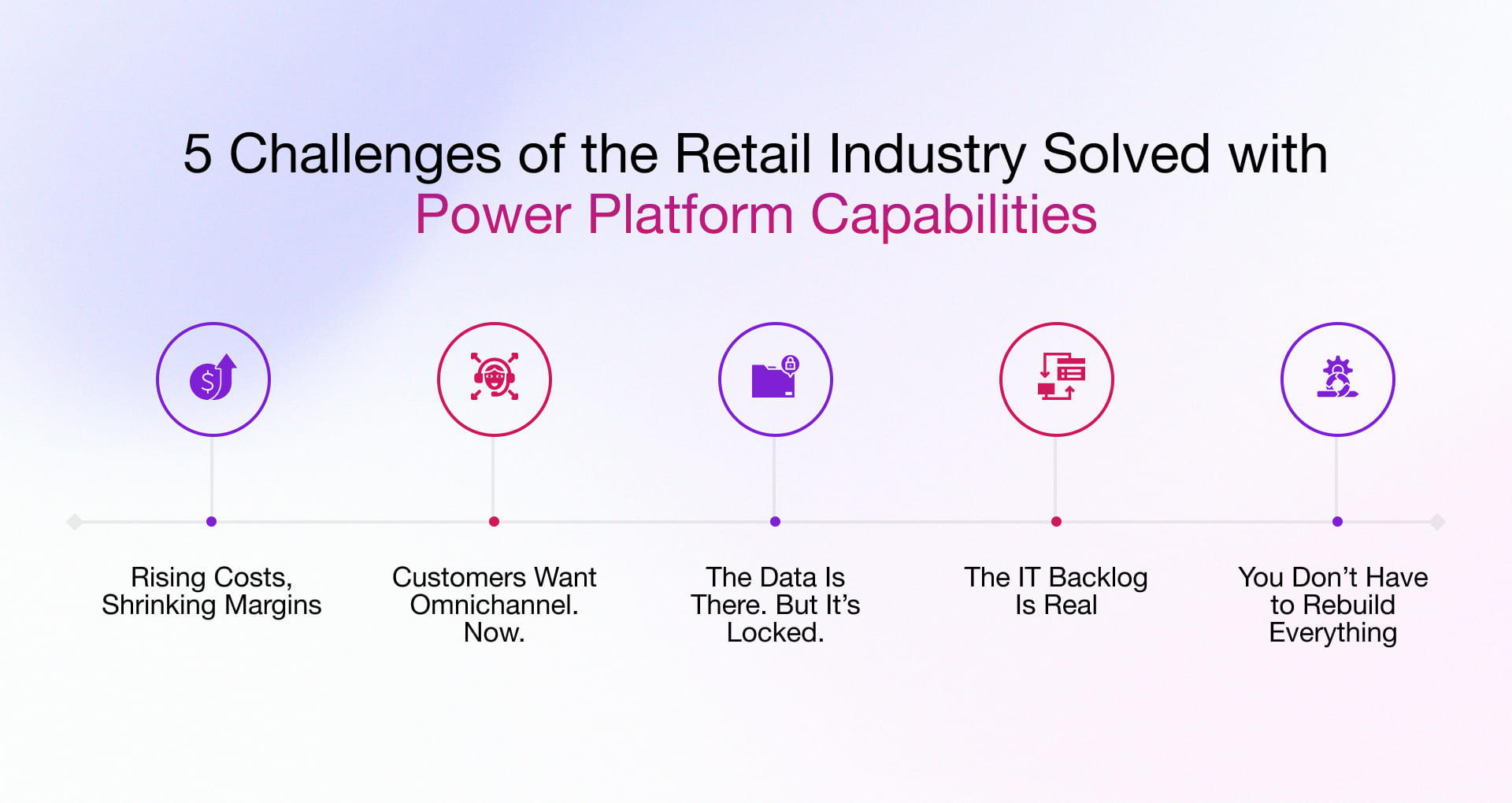
1. Rising Costs, Shrinking Margins
Rising wages, higher logistics costs, and inventory volatility are squeezing profits. Yet many retailers still rely on manual processes—store audits on paper, approvals over email, and siloed data entry that eats up hours daily.
This is where Power Automate in retail plays a key role. It helps automate repetitive, low-value tasks without custom development. Store managers can set up approval flows, automate inventory alerts, or even trigger supplier restocks—all with minimal IT help. It’s not just faster. It’s cost-efficient.
2. Customers Want Omnichannel. Now.
Customers expect seamless omnichannel experiences—real-time inventory across online and offline, personalized offers, and self-service options. Meeting these expectations quickly is challenging when legacy systems and IT bottlenecks slow down innovation.
But with Power Apps for retail, frontline teams can build and deploy custom low-code tools in days. Whether it’s a mobile app to check stock availability or a tool to capture in-store feedback, Power Apps allows you to put innovation in the hands of store managers and operations teams—without waiting for full-scale development cycles.
3. The Data Is There. But It’s Locked.
Data is another pain point. Most retailers sit on massive volumes of operational and customer data but struggle to turn it into insights. BI tools are either too complex or disconnected from the real-time retail workflow.
Power BI changes this. It integrates seamlessly with existing systems—POS, ERP, CRM—and gives decision-makers a single view across channels. You can track sales by region, measure campaign effectiveness, or forecast demand spikes precisely. It’s real-time intelligence that drives real-time action.
4. The IT Backlog Is Real
The most compelling reason for retail leaders to consider Power Platform now is scalability without disruption.
You don’t need to rebuild your tech stack. Power Platform connects with what you already have—Dynamics 365, Teams, third-party POS, CRM tools, and more. You can modernize legacy systems incrementally. This is especially important for enterprise chains where a complete overhaul is not feasible or desirable. Plus, with Power Platform Copilot and AI-enabled automation, the platform gets smarter over time, offering even more value as you grow.
5. You Don’t Have to Rebuild Everything
What makes Power Platform even more relevant now is that it doesn’t require a full replatforming or complex integration efforts. Retailers can modernize their processes while still working with their existing infrastructure.
Power Platform in retail industry seamlessly integrates with tools like Dynamics 365, Microsoft Teams, POS, CRM, and third-party systems, reducing the need for costly overhauls. This is a significant advantage for enterprise retail chains with large, distributed operations that need scalable solutions that don’t disrupt the business.
Field-Proven Retail Operations Scenarios with Power Platform
From inventory tracking to frontline empowerment, Microsoft Power Platform is helping retailers modernize operations and drive measurable impact. These aren’t concepts but proven use cases implemented at scale.
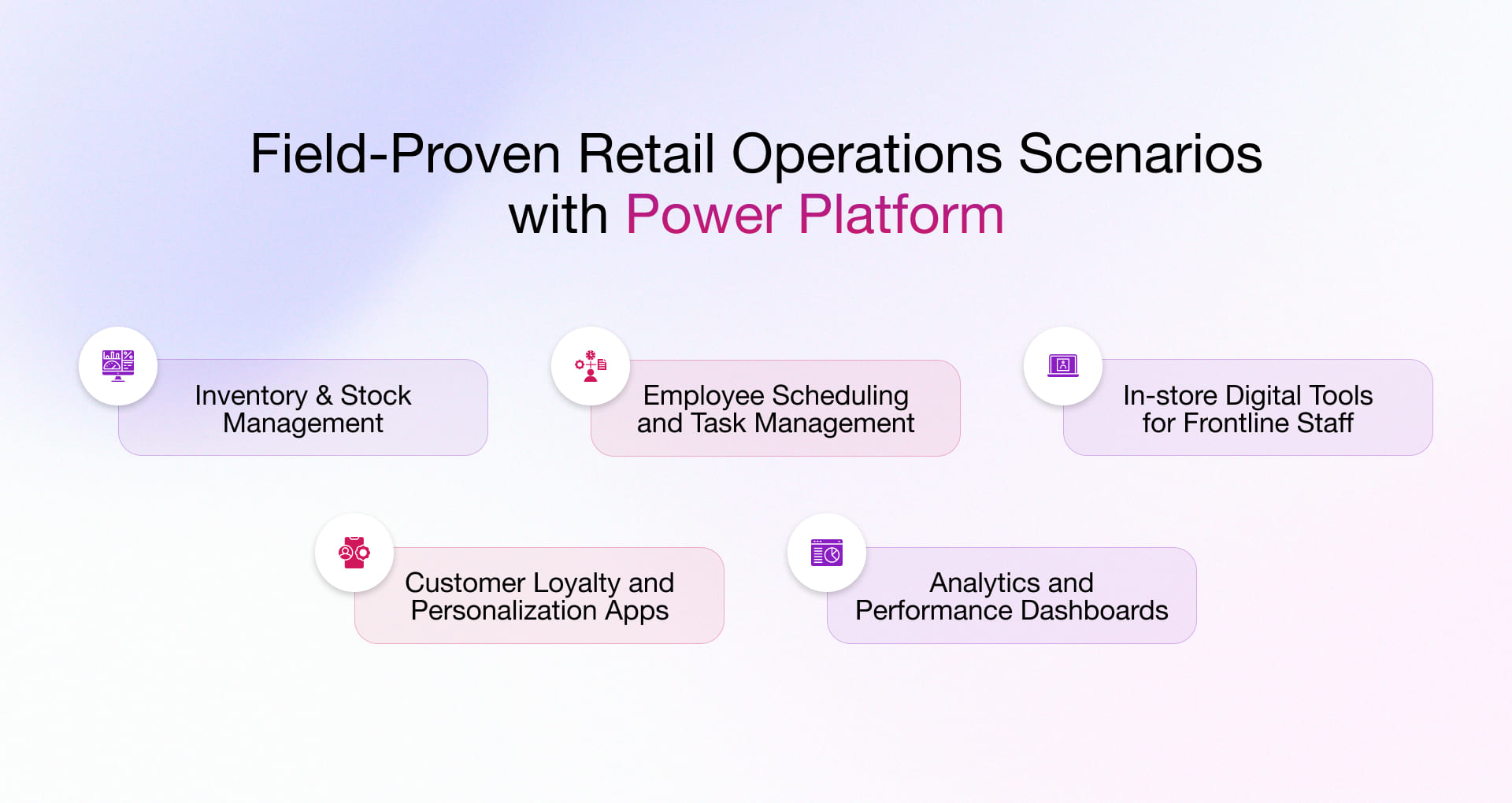
Inventory & Stock Management
Managing stock manually across multiple stores often leads to delays, inaccuracies, and lost sales. Using Power Automate and Power Apps for inventory management, retailers are building simple mobile apps that allow store managers to update inventory in real time, receive restock alerts, or even trigger reorders automatically based on stock levels.
Grupo Bimbo[1], one of the world’s largest bakery companies, used Power Platform to digitize stock intake, product returns, and delivery reconciliation, improving accuracy and reducing paper-based inefficiencies. The solution enabled real-time inventory visibility across stores and warehouses, helping staff restock faster and reducing losses from unsold goods.
Employee Scheduling and Task Management
Staffing is one of the most complex parts of running a retail chain. Manual scheduling often causes overlaps, coverage gaps, or employee dissatisfaction. Power Apps have helped store leads build scheduling tools that consider availability, shift preferences, and peak hours.
Paired with Power Automate, these apps sync with Teams, notify staff about their shifts, and allow last-minute swaps—without relying on spreadsheets or external software.
As outlined in Microsoft’s retail productivity blog[2], companies are leveraging Power Platform to improve workforce operations without building tools from scratch.
In-store Digital Tools for Frontline Staff
Store associates often lack the digital tools to support customers effectively. Power Apps for retail equip staff with mobile apps that give access to product catalogs, pricing, store layouts, or customer order history—all from a tablet or phone. This not only improves the customer experience but also reduces dependency on supervisors or paper-based systems.
Customer Loyalty and Personalization Apps
Personalization is no longer a nice-to-have. It’s expected. With Power Platform, marketing teams can build lightweight apps to manage loyalty programs, segment customers, and send targeted offers using Power Automate and CRM integrations.
For instance, Coop Denmark[3], one of the country’s largest grocery chains, built a personalized loyalty app using Microsoft Power Platform. Users receive offers tailored to their shopping habits, track purchases, and get digital receipts. With Power Apps and integration into Microsoft Dataverse, Coop’s marketing team can easily segment users and deploy personalized promotions, without relying on external platforms.
This resulted in increased user engagement and repeat purchases, while also reducing customer service inquiries through automated workflows.
Analytics and Performance Dashboards
Data powers retail decisions—but siloed tools slow down insights. With Power BI, retailers are building unified dashboards that consolidate:
- Sales performance
- Inventory turnover
- Foot traffic and customer sentiment
These dashboards empower teams—from store managers to corporate leadership—to make faster, data-informed decisions.
Real-time Sales Visibility for a Global Retailer
We helped a leading retail brand move beyond spreadsheets by developing a unified Power BI sales dashboard. The team gained real-time insights and streamlined reporting by 20% by consolidating regional sales data into a single view. It empowered store managers and leadership to make a 4x improvement in effective decision making. A clear win for operational clarity and business agility.
Learn more about our process and client’s success here.
Solving Real Retail Challenges with Our Power Platform Expertise
Retail moves fast. We help you move faster—with the right mix of strategy, tools, and hands-on support.
At Rishabh, we don’t just know Power Platform—we know how to make it work for retail. From inventory management to store performance dashboards. As an experienced Microsoft Power Platform consulting service provider, we’ve helped businesses solve real-world problems with custom apps, automation, and analytics.
Here’s what we bring:
- Retail-specific solutions, not one-size-fits-all tools
- Low-code development that moves fast and scales easy
- Automation that cuts down manual effort and errors
- Dashboards that turn raw data into clear decisions
- Integration with your existing systems—ERP, POS, CRM, and more
Case Study: Enabling Real-Time Inventory Visibility for a Leading Supply Chain Organization
A US-based warehouse and services enterprise supporting retail supply chains needed real-time inventory visibility. Fragmented, manual data made decisions slow and planning unreliable.
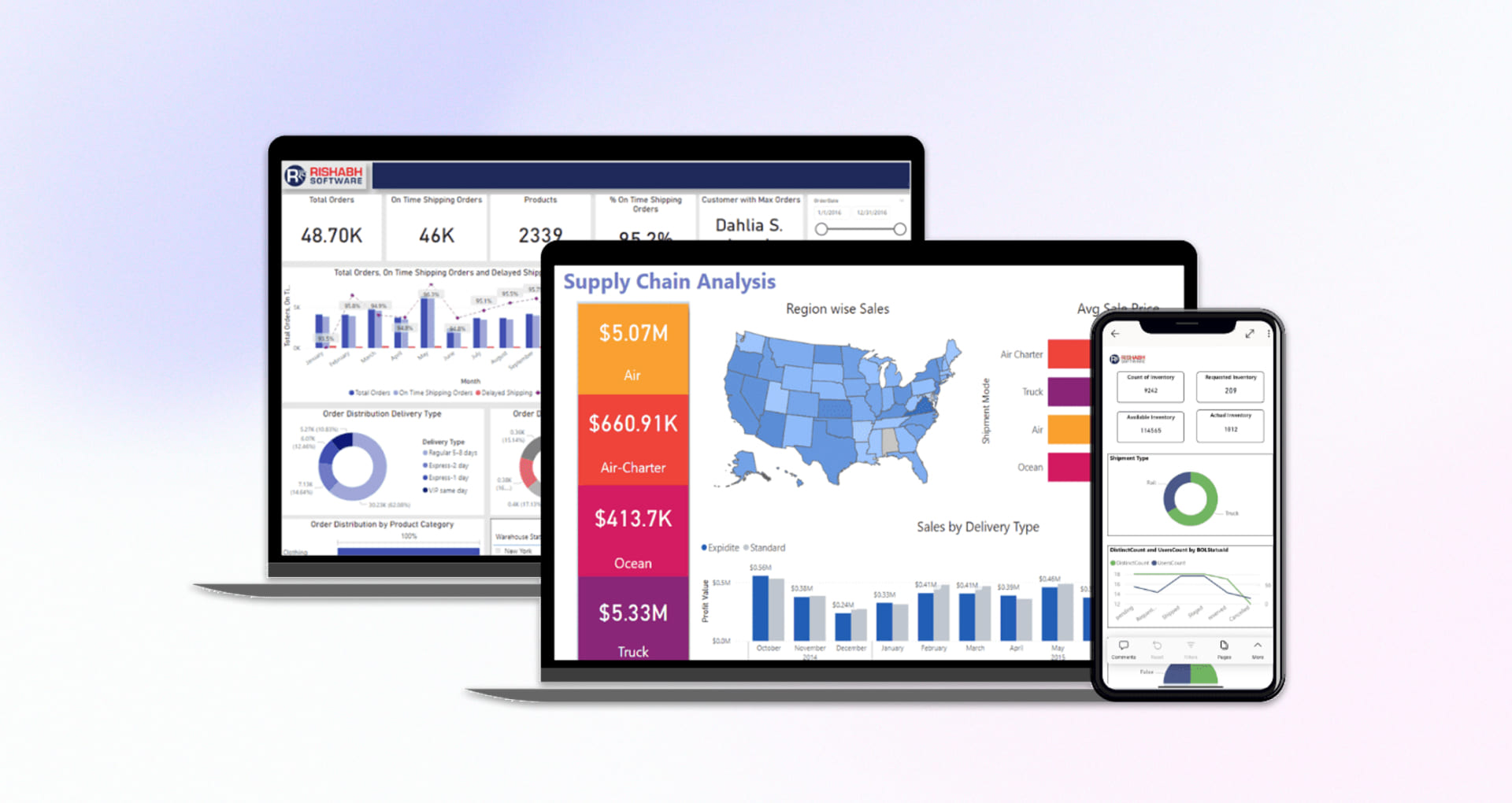
Our Solution
We built a centralized inventory dashboard using Power BI and SharePoint, automating reports, visualizing KPIs, and enabling secure, cross-functional access.
Results:
- 100% automation of inventory reporting
- 92% boost in data availability
- 6.2% improvement in inventory turnover
With Power Platform for Retail, you don’t just digitize, you gain visibility, speed, and control.
FAQs
Q – How can Power Platform help modernize legacy retail systems without a full replatforming?
A – Power Platform bridges legacy tech with modern capabilities without forcing a rip-and-replace. By leveraging Power Apps and Power Automate, you can wrap around existing systems, digitize paper-based processes, and build low-code apps that work with your core infrastructure. It’s modernization with minimal disruption and faster ROI.
Q – Can Power Platform scale to meet the needs of enterprise retail chains?
A – Yes. Power Platform is built on Azure, which means it scales seamlessly—from a single store to thousands across regions. Whether you’re deploying AI-powered chatbots with Power Virtual Agents or automating inventory workflows chain-wide, the platform adapts to volume, complexity, and evolving demand.
Q – How secure and compliant is Power Platform for regulated retail environments?
A – Very. Power Platform aligns with enterprise-grade security standards, including ISO 27001, SOC, GDPR, and more. With built-in data loss prevention (DLP) policies, role-based access, and integration with Microsoft Purview, you stay audit-ready while building retail solutions faster.
Q – How does Power Platform integrate with our existing tools like POS, ERP, or CRM systems?
A – Native connectors make integration seamless—whether it’s Dynamics 365, SAP, Oracle, or custom POS systems. Using Power Automate and Dataverse, you can create real-time sync between frontline tools and backend systems, unlocking unified data flow and a 360° customer view.
Q – How do you help accelerate time-to-value with Power Platform?
A – We focus on quick wins with high impact. From day one, our approach is use-case-first: identify bottlenecks, deploy ready-to-go app templates, and scale iteratively. With low-code velocity and built-in intelligence, we help retailers move from idea to outcome in weeks—not months.
Footnotes:
1. https://www.microsoft.com/en/customers/story/22185-grupo-bimbo-microsoft-power-platform
2. https://devblogs.microsoft.com/powerplatform/unlock-retail-productivity-with-power-platform-and-dataverse/
3. https://www.microsoft.com/en/customers/story/1414624305368286027-lobyco-retailers-azure
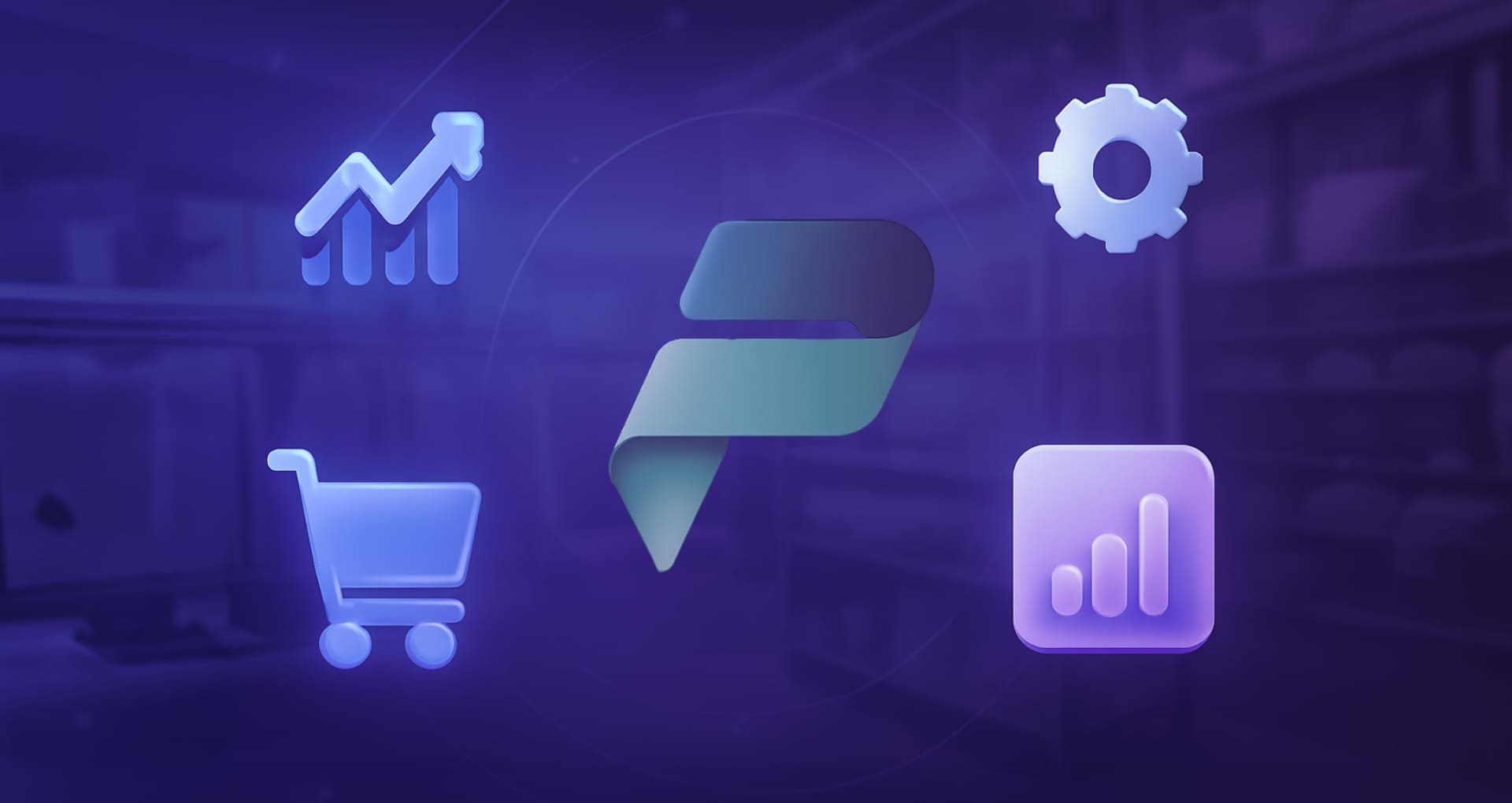




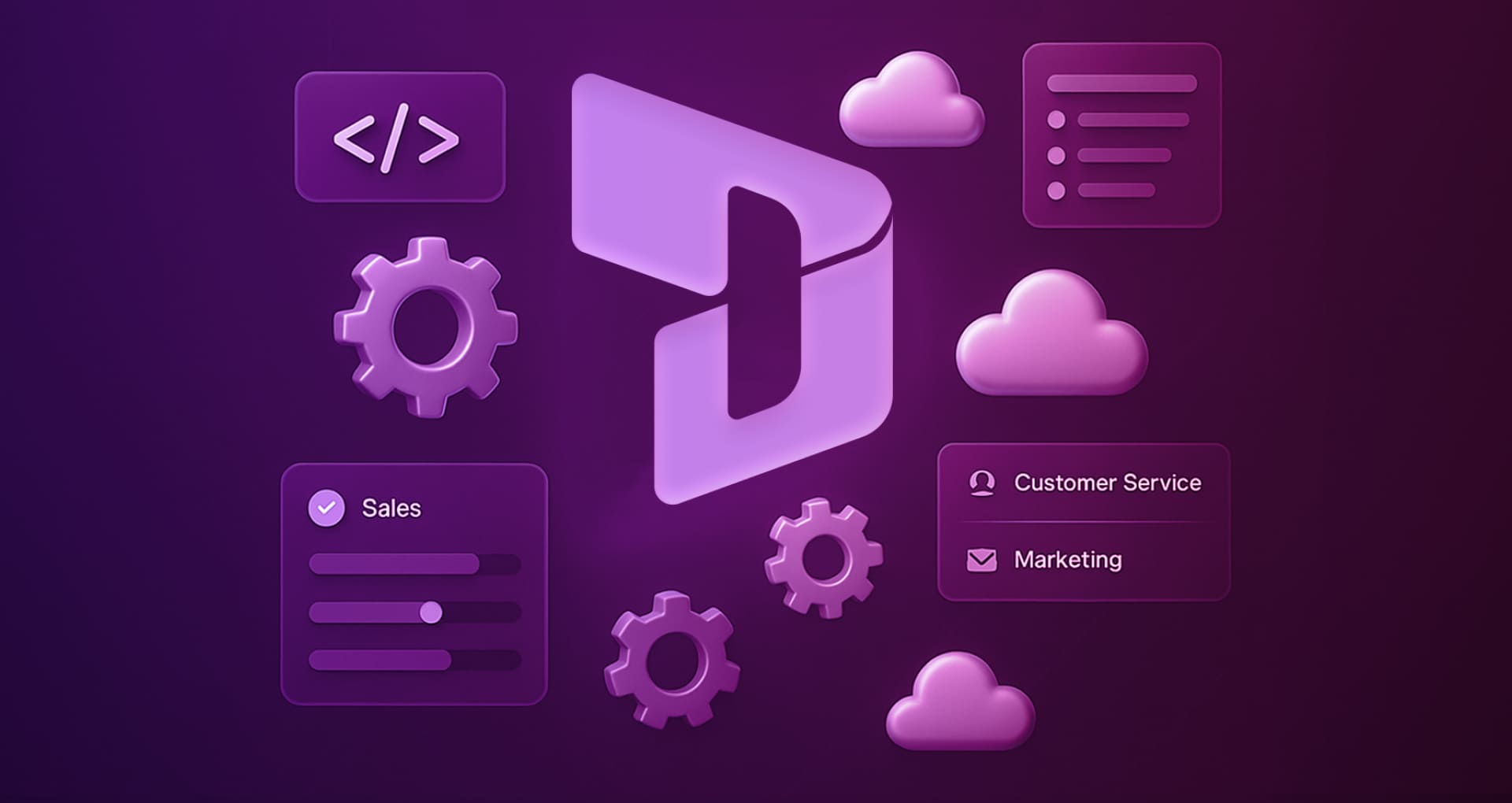





 30 Min
30 Min


